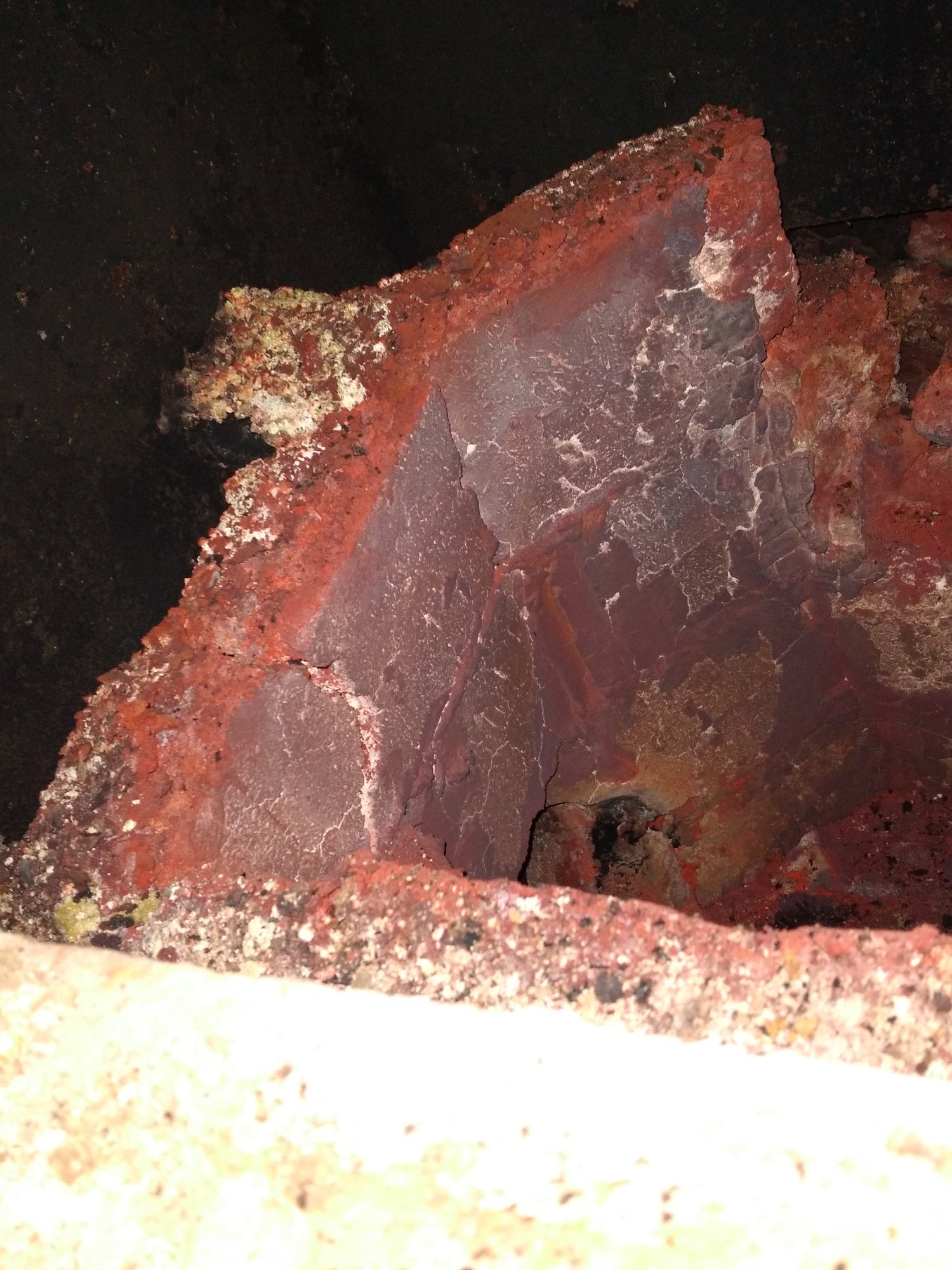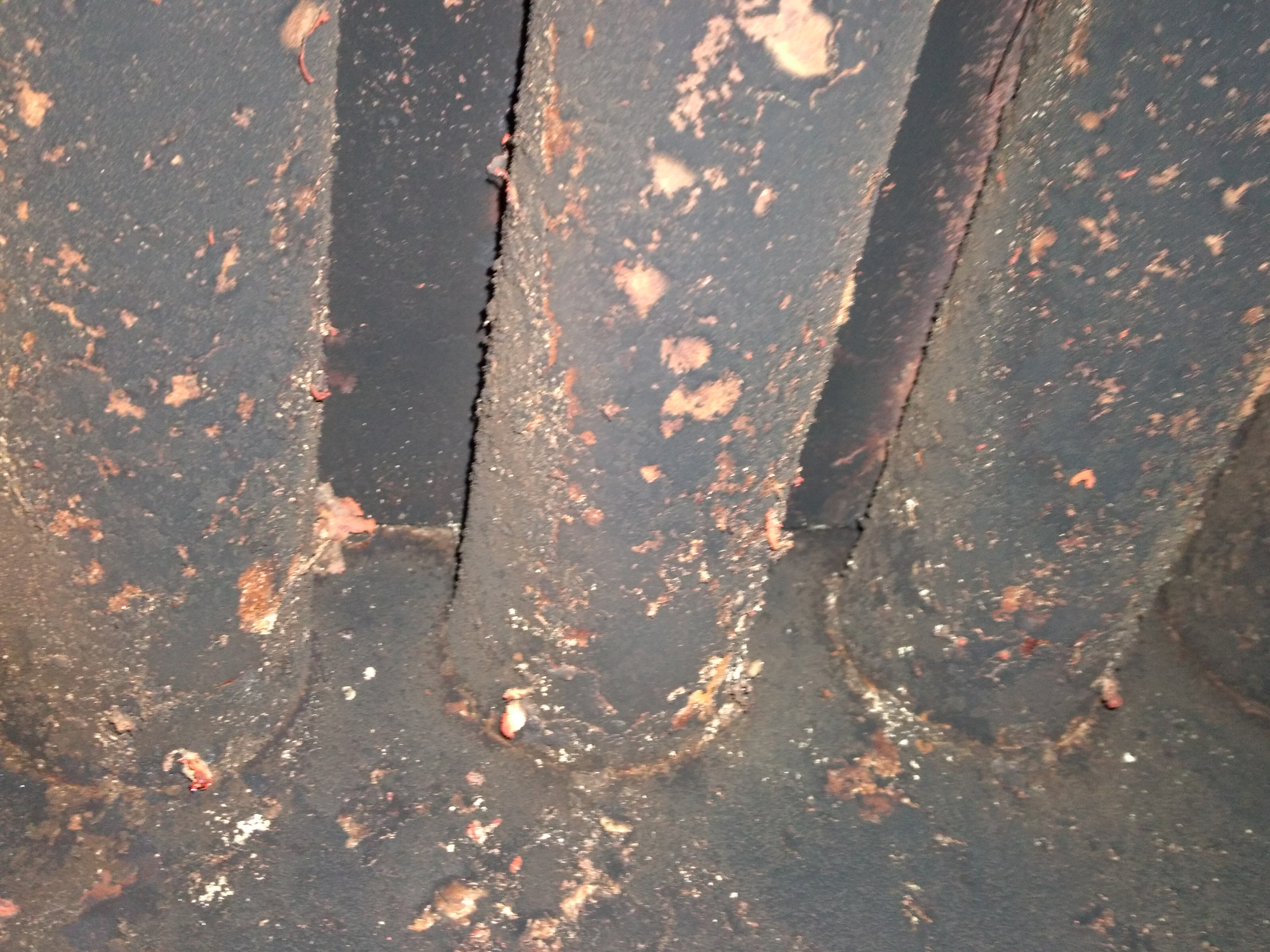Welcome! Here are the website rules, as well as some tips for using this forum.
Need to contact us? Visit https://heatinghelp.com/contact-us/.
Click here to Find a Contractor in your area.
If our community has helped you, please consider making a contribution to support this website. Thanks!
Combustion chamber in pieces!
Options
Nbkbar7955
Member Posts: 2
in Oil Heating
Okay, brief history:
original owner built the house in 1948. When she passed, family sold house to 2nd owner. They lived here abt 10 years, selling me the house in 2019. I've run the system for 2 seasons.
As far as I can tell, the 2nd owners never did any maint with the exception of the beckett (I found an old nozzle). There are no tags anywhere indicating what was done, who did it and when it was done.
So inprep for the upcoming season I decide to get the heater ready by following instructions from the internet.
I open the door (almost an impossible task) and discover the combustion chamber is rubble.
I can't find a removable panel to remove / replace the chamber. S I'll have to fix it from the access door.
So I'm looking for a little direction.
1. Is the combustion chamber a precise size and shape on a boiler this old?
2. If I use ceramic blankets how are they attached to "whatever"?
3. Am I thinking in the right direction with the blanket material insead of trying to replace bricks?
lots of other question later
Thanks for any imput!
- Dave




















0
Comments
-
Looks like you have your work cut out for you.
The inside of your combustion chamber should be sized to 90 sq" of floor area/gallon of fuel burned (although this can be exceed without issue) 90 square " for a 1 gallon nozzle, 135" for a 1.50 nozzle. This is assuming your running 100psi oil pressure adjust accordingly for different firing rate with higher oil pressure. But check the Beckett oil burner manual for the correct shape and nozzle
The real issue is that you likely have asbestos material in that chamber.
I would check the burner nozzle size and firing rate and then see if you carefully clean out some of the rubble you might be able to drop a new chamber inside without disturbing the old. A lot of old chambers are way oversized. or line it with Cerafelt
Check out Lynn products, they make chambers etc and refer to the Beckett oil burner manual for sizing the chamber
Also Westwood Products, I think they were recently bought out by Beckett0 -
Ed, both you and I have repaired things that any younger person would condemn.
That boiler and probably burner is 1 year older than me.
Would a new install be out of line? I don't do any oil anymore, but 30 years ago would have welcomed the challenge to fix this up. Today, well it seems time to upgrade.
But then it is not my money.
Can you explain how the water tube system works in this. There are 22 what look to be pipe plugs on the back of the boiler. Are two of each connected, as with internal tees, that removing the plugs you could clean/inspect the water tubes?0 -
I think because you're not schooled in oil burners (and YouTube doesn't count), and it seems to have a 90 second stack primary, the safest and smartest thing would be to check the "Find a contractor" link and see if anyone can really help you.
The chamber isn't the only concern, there's evidence of incomplete combustion.
The "FUEL SAVER" pic is my favorite.
I hope the bearing assembly doesn't blow a seal also.1 -
The op asked about the combustion chamber so I didn't address anything else
@JUGHNE
Steel boiler were made in "fire tube" (fire in the tubes or "water tube" (water in the tubes).
Examples of fire tubes are the old HRT boilers , scotch marine boilers (like a Cleaver Brooks) Steel firebox boilers like Kewaneee, Fitzgibbons and a million others.
I think most of the water tubes were usually really large boiler for hospitals and industry, power generation, Babcock & Wilcox, International Boiler Works (as above)
I know Bryan Steel boilers makes a "Flexible Tube" model you can google it.
Basically, water tubes have return header(s) and a supply header. The tubes which have water inside and are exposed to the fire run between the return header(s) and the supply header. Return water enters the return header gets heated and turned to steam in the tubes and the steam rises to the supply header.
Actually the old HB Smith boilers 350/3500 450/4500 650/6500 and the real old 24s, 34, 44, etc. were cast iron water tube boilers. They had 2 return drums and 1 supply header0 -
Okay, I apologize for taking so long to respond. it's been a roller coaster of a week.
EBEBRATT-Ed:
Thank you SO much for mentioning the possibility of asbestos!! Hadn't even crossed my mind.
When I read that I immediately went down stairs and locked the door. No one goes in with out my knowledge (really pissed off Sandy, her laundry is down there, we're using the laundromat now.
I got an inspector in and he said that it is possible that there may not be asbestos in there, but because of the age its most likely that there is. After checking the rest of the house he said that its localized to the combustion chamber. He took a sample and the next day it came back positive (no surprise right?). The abatement team started Friday and are supposed to be finished mid to late this week.
So until I'm allowed to get back in there everything is on hold.
Again thanks for the heads up.
Inside the chamber should be 90 sq"? Or 90sq" per gallon of fuel burned? As I get closer to that point I'll probably be asking about this again.
Lynn has been a great help providing insight and assistance. They didn't have a drop in replacement but they are an invaluable resource for rebuilding.
The water tubes and heat exchange is also an area I want to understand. I hope to bring that up later also.
Hvacnut:
You are correct. I have no experience in oil burners. I had already setup for a heating expert to service the beckett. Not an area I would want to make a mistake in.
Not quite understanding what your trying to explain to me but again I'd like to revisit later if you don't mind.
If stack primary refers to the stack switch, I have replaced that with an electronic control, part of a computerized replacement for the mechanical equipment on the system. I have it set to allow 30 seconds from the call to fire the beckett. If the temp doesn't increase appropriately within that time frame everything is shutdown and a manual reset is required. Electronic Engineering is where my expertise lies.
Jughne:
Yep! definitely time for upgrade or replacement. But that would take all of the fun out of it. I'm a retired industrial automation engineer and just wanted a new project. However as Ebebratt-Ed pointed out this project's a little bigger than I originally thought...
I'm a retired industrial automation engineer and just wanted a new project. However as Ebebratt-Ed pointed out this project's a little bigger than I originally thought...
Anyway thank you all for your input, warnings and advise! As things progress I'd like to keep getting your feedback.
Thx!
- Dave0 -
@Nbkbar7955
90 square " of floor area/gallon of oil burned. That is the minimum size. You can exceed that # by quit a bit with the so called "modern burners" and with Cerafelt or lightweight fire brick that heat up fast.
I would check the Beckett burner manual also for chamber size and shape. The height of the nozzle above the bottom inside of the chamber also has a minimum dimension. Round chambers are usually preferred to square or rectangular if you can0 -
The old timers here who have worked on oil heat have replaced that particular combustion chamber with ceramic fiber chamber made by Lynn Manufacturing. The Time Saver and the Quickie were a common generic or "Fits All" combustion chamber.
https://www.supplyhouse.com/sh/control/product/~product_id=1001
https://www.supplyhouse.com/Lynn-Manufacturing-1009-Universal-Combustion-Chamber-Kit-Lynn-Time-Saver-9-2300F-Ceramic-Fiber
If you can't find an oil heat person that is willing to replace your chamber, and you need to address this yourself, you can ask me for assistance here or by PM. There are a few things that you need to address when you do this job. For example: In this picture
the bottom of the steel header, indicated by the arrows, is known as a Mud Leg. There may be a build up of sediment inside the water jacket. This sediment or "Mud" can keep water inside the water jacket from making contact with the steel. This area needs to be protected from the intense heat of the flame, otherwise the steel can be overheated and will fail. The combustion chamber acts as insulation to keep this area from overheating.
You may also want to add vermiculite to the area between the replacement combustion chamber and the firebox. This will reduce noise and hold the chamber in place. Vermiculite is fire-proof and a great insulator.
Your best bet is to find someone that is old enough to remember how to do this with a younger helper that wants to learn how to do this. Outside of that, you may be doing this yourself.
Yours truly,
Mr.Ed
Edward Young Retired
After you make that expensive repair and you still have the same problem, What will you check next?
0 -
@EdTheHeaterMan said
"with a younger helper that wants to learn how to do this" LOL
A dirty nasty job
The vermiculite being sold today, anyone know if this is asbestos free? I would think it would have to be.1 -
Is less than 1% asbestos still considered not an asbestos containing material?0
-
@Nbkbar7955 , that Beckett burner is a current model. It should be upgraded with a current primary control that is UL approved and has a 15-second trial for ignition, and can cut the ignition spark off after the flame is established. These controls use a photoelectric cell to prove the flame and act very quickly. This will bring the burner control setup into the 21st century.
If I were replacing that firebox, I'd probably use a Lynn Timesaver in the proper size for the burner's capacity. Your boiler is a "dry base" type and the Timesaver is specifically designed for these. The nozzle spray pattern would have to match the Timesaver's diameter, often this would require a hollow-spray nozzle.
Where are you located?All Steamed Up, Inc.
Towson, MD, USA
Steam, Vapor & Hot-Water Heating Specialists
Oil & Gas Burner Service
Consulting1
Categories
- All Categories
- 87.3K THE MAIN WALL
- 3.2K A-C, Heat Pumps & Refrigeration
- 61 Biomass
- 429 Carbon Monoxide Awareness
- 120 Chimneys & Flues
- 2.1K Domestic Hot Water
- 5.8K Gas Heating
- 115 Geothermal
- 166 Indoor-Air Quality
- 3.7K Oil Heating
- 77 Pipe Deterioration
- 1K Plumbing
- 6.5K Radiant Heating
- 395 Solar
- 15.7K Strictly Steam
- 3.4K Thermostats and Controls
- 56 Water Quality
- 51 Industry Classes
- 50 Job Opportunities
- 18 Recall Announcements


